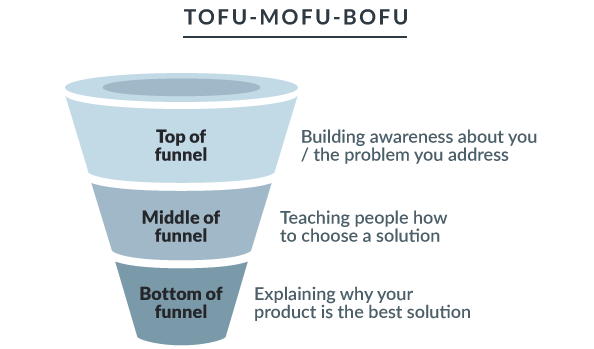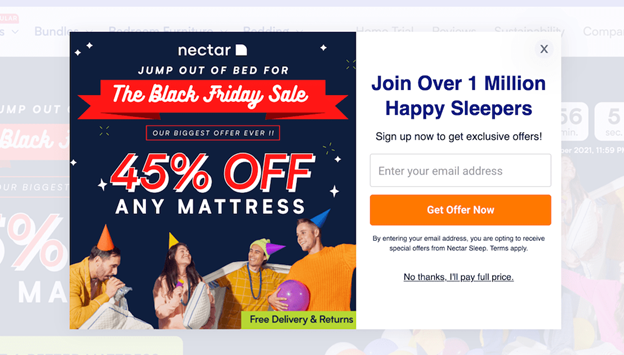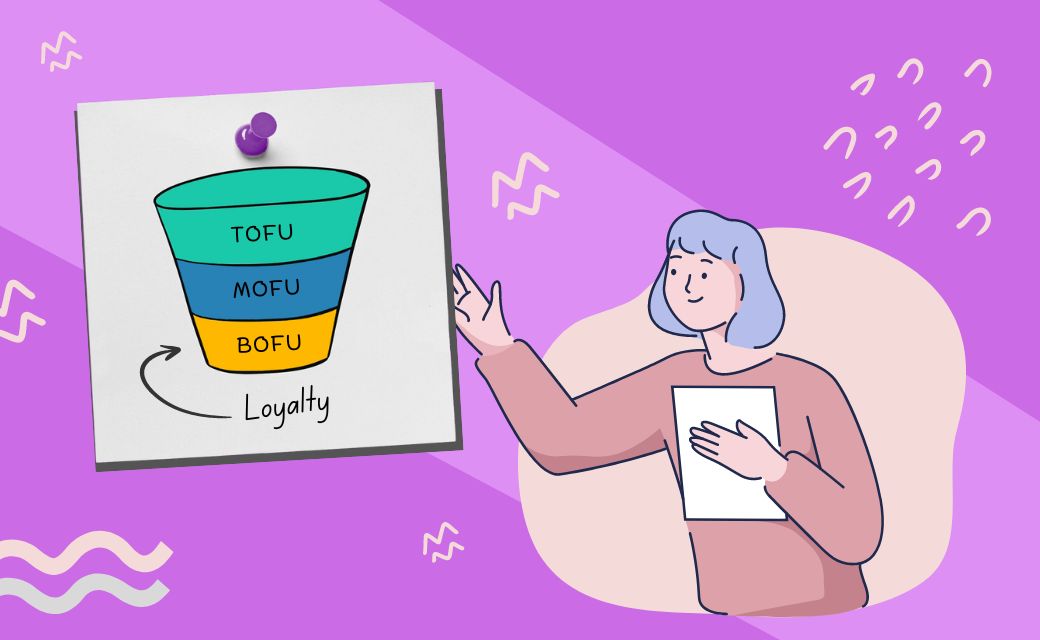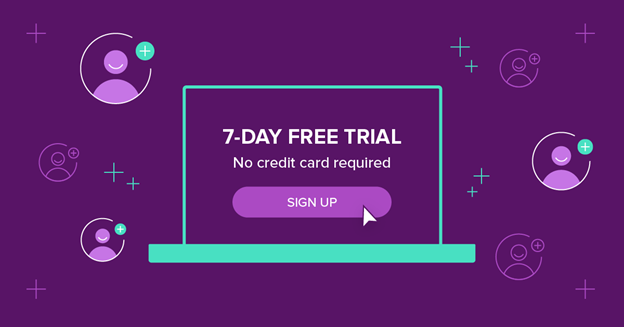What is Bottom of the funnel (BOFU) marketing?
The term Bottom of the Funnel, or BOFU, represents the final stage in a consumer’s journey — the cusp where interest turns into action. Imagine a funnel: wide at the top, narrow at the bottom. The top is where awareness resides, like a crowd of spectators at a sports match. But as you descend, the spectators turn into players, committed and focused. By the time you reach the funnel’s base, only the most committed remain, and it’s here that the actual conversions take place.
But what does this look like in marketing terms? What is Bottom of the Funnel Marketing? Simply put, it is a series of targeted strategies and content pieces designed to convert a lead into a customer. Whereas the top of the funnel is about creating awareness, and the middle is about consideration, the bottom is about decision and action. Here, the rubber meets the road.
You’ve piqued their interest with your blog posts and educated them with your white papers and case studies. Now, it’s time for the final push. Your BOFU strategies could involve things like product demos, customer testimonials, or highly targeted offers—essentially, anything that will tip the scale from “maybe” to “yes.”

If you consider a chess game, the BOFU stage is like the endgame where every move is critical, and even a slight mistake can cost you dearly. Your content must be precise, your offers irresistible, and your call-to-action unambiguous. You need to convince your audience not just that your product is beneficial, but that it is the solution to their specific problem.
Understanding What is Bottom of the Funnel Marketing and effectively implementing it can be the difference between a game lost and a game won, between a lead lost and a customer gained.
Why does BOFU content matter for your sales?
BOFU content or Bottom of the Funnel content matters because it plays a big part in conversion. It is tied to a goal – which is conversion. Let us understand that by the time the customer arrives at this stage of the buying journey he is already interested to go with your brand, but still needs a slight push. He is still comparing with other brands, but he is willing to invest in your brand services/products if he gets the right things.
This is where Bottom Funnel content matters. IT HAS HIGH Intent. As opposed to any other content in any other part of the funnel, this is the part where people want to buy. And that makes all the difference.
In marketing, your customer is the protagonist, and the ‘ultimate test’ is their decision to commit to your brand. Consider your BOFU content as the persuasive argument that helps in making the buying decision.
Your BOFU strategy can significantly influence whether a prospect chooses your product over a competitor’s. At this stage, the customer has likely whittled down their options to a few choices, and your BOFU content is your chance to tip the scales in your favor.
It’s not just about closing a sale; it’s about establishing a long-term relationship. Superior BOFU content doesn’t just convert; it also sets the stage for customer loyalty. In the larger scheme of marketing, BOFU content is the intricate detail that completes the picture. It adds the finishing touches, converts leads into sales, and transforms one-time buyers into loyal customers.
Without effective Bottom of the Funnel content, your marketing strategy is like a symphony missing its final, climactic note.
Bottom-of-Funnel Content Key Elements
The potency of your Bottom of the Funnel content lies not just in its intent but also in its components. Each element must be meticulously chosen, like the ingredients of a Michelin-star dish, to create a compelling narrative that prompts action.
Here are the main elements of great BOFU content.
1. Has to focus exclusively on people who are about to buy and and their pain points
Unlike TOFU content, at the bottom funnel you have to specifically target the people who you think are about to buy from you. Think of this as people standing outside your shop, but also checking out the other shops selling the same thing. They are almost drawn to your shop but, but, but, they are also drawn a tiny bit to the other shops too. In this case, your content has to show how your product fit is better and how your service can help solve their problem better.
2. Has to focus on benefits
Your BOFU content has to talk about what benefits it offers your target audience. What are all the reasons someone should buy your product/service? What is that one or two things that will draw them to you and you only. THINK BENEFITS, add benefits. Focus on the benefits that you offer and your competitors do not. Focus on the benefits that your TG cares about.
3. Offer Social Proof
The backbone of effective BOFU content is trust. Utilize social proof such as testimonials or case studies that resonate with your target audience. Customers always want to know that others have taken the product and benefitted from your service. It confirms to them that they are making the right choice. There is nothing better than well-done testimonials at BOFU level.
4. Has to be Product-led
In a BOFU content, you need to talk about the benefits and advantages of using your product or service. Make the benefits about the pain points of your user. Once you have talked about that, back it up by showing how and which features help you get those benefits.
For example, at Justwords, we differentiate our agency’s work with a quality guarantee. The pain point for several of our customers who contact us has been quality. We explain how our system works, and the way we work to ensure quality.
Don’t just talk about your product’s features in your BOFU. Explain how it can solve a problem for the user.
Use a video to explain what are the advantages of using the product and situations when you can use it. This helps the customer better connect with your product or service.
5. Should have a clear call-to-action (CTA)
With BOFU content, be extremely clear on how you want your customer to act. Ambiguity is your enemy at this stage. The CTA should guide the prospect, making the next steps obvious and easy.
Bottom of the Funnel Offers are the cherry on top. These are your last-minute enticements, the extra push to help your potential customer make that leap from consideration to purchase. They should be irresistible, and should make the customer act immediately.
Bottom-of-Funnel Metrics: How to Measure BOFU Performance
In the world of Bottom of the Funnel Marketing, metrics serve as your navigational tools. They give you a concrete way to assess the effectiveness of your BOFU strategies, like data points that become the basis to measure the effectiveness of a campaign’s success.
Here are some metrics to track for your BOFU content.
Conversion Rate:
Let’s start with the Conversion Rate. This number tells you how many leads have successfully turned into customers. A low conversion rate could signify a disconnect in your Bottom of funnel marketing content or offers, alerting you to reevaluate your strategies or the content. It’s the business equivalent of a health check-up; ignore it at your peril.
Customer Lifetime Value (CLV):
This is another vital metric. It measures the total revenue a customer will generate for your business over the course of their relationship with you. It’s essential to understand that BOFU doesn’t end with a single transaction. Your ultimate goal is to cultivate long-lasting relationships, and CLV gives you an indicator of how well you’re doing in that regard. It is a barometer for customer loyalty.
Cost Per Acquisition (CPA):
This metric shows you how much you’ve spent to acquire a new customer. It essentially indicates the efficiency of your BOFU content and strategies. If your CPA is high, it may be time to reconsider your tactics. You might be pouring water into a sieve, wasting resources without adequate returns.
The Engagement Rate:
This shows how well your content resonates with your audience. It encompasses metrics like page views, time spent on your website, and social media interactions. Gauging engagement rates is vital for any business. A disengaged audience is less likely to convert, which means you may need to fine-tune your content to better capture their attention.

Top of Funnel vs Bottom of Funnel Marketing
Trying to do well in content marketing is like traversing a complex maze; each turn has its unique challenges and rewards. One of the most critical distinctions you must grasp is the difference between Top of the Funnel vs Bottom of the Funnel Marketing. While both stages play significant roles in your overall strategy, they serve different purposes and require distinct approaches.
Here are the main differences between BOFU and TOFU content.
| Top of the Funnel | Bottom of the Funnel |
|---|---|
| Focus: Awareness and education. Uses keywords with higher volume and low buying intent | Focus: Conversion. Uses keywords which have low search volume, transactional in nature, and high buying intent |
| Target Audience: Broad audience | Target Audience: Specific, interested leads |
| Content Examples: Blog posts, social media updates, informational videos, webinars, podcasts, whitepapers, infographics | Content Examples: Product demos, case studies, testimonials, comparison pages, detailed product feature pages. |
| Goal: Pique interest, attract leads | Goal: Convert leads into customers |
| Marketing Strategy: Casts a broad net to capture leads | Marketing Strategy: Focuses on those who have shown genuine interest |
| Relationship: Feeds leads into the bottom of the funnel | Relationship: Converts leads into revenue |
| Key Importance: Attraction | Key Importance: Conversion |
| Analogy: Casting a broad net | Analogy: Closing arguments in a courtroom |
| Integration: Crucial for overall strategy | Integration: Indispensable; integration is key |
| Importance of Both: Both are indispensable | Importance of Both: Integrating for optimal results |
When considering Upper Funnel vs Lower Funnel Marketing, it’s crucial to understand that these are not isolated silos but parts of a cohesive strategy. The top of the funnel feeds the bottom. It’s a symbiotic relationship. The top-of-the-funnel draws in leads which the bottom-of-the-sales funnel converts into revenue.
In essence, the top of the funnel is about attraction, while the bottom is about conversion. Both are indispensable in their own right, but their ultimate power lies in how well they integrate with each other. Ignoring one in favor of the other is akin to trying to sail a boat with only one oar; you might move, but you won’t get far.
Bottom-of-Funnel Tips to Increase Conversions
How do you increase conversions with your BOFU content? Here are some tips to make your BOFU pages super solid and primed for conversions.
1. Tie the customer pain points to your unique selling points, to your products features and benefits. If you don’t know what their pain points are, find out. Think of yourself as a problem solver, offering a solution that’s tailored to their unique situation.
2. Narrow down your focus. You are just a step away from conversion. What can you offer at this point? What urgency can you create? Be honest and genuine in what you offer, since your audience can spot insincerity a mile away.
3. Do not bother about shiny high volume keywords that are meant for top of the funnel. For example, for us, content marketing is a top of the funnel keyword. If you are a dentist, “dentist” or “root canal” will be a high volume top of the funnel keyword.
Transactional keywords, which will have a lower volume but very high buying intent, are perfect for BOFU.
For example, content marketing services in UK, social media agencies in India, dental cleaning services, dentist office in Cleveland etc
Go for transactional keywords that people will search and which will have a large buying intent attached to them. These will not get you much traffic, but they will get you sales.
4. Talk to your sales team to understand what are the main problems faced by customers and then talk to your product team to understand the features better and how they solve problems. Finally, also talk to your customer support team to understand what are the things that are still missing.
5. Use AI to understand the gaps in your landing page, after you have fed it with data on your Ideal customer profile and your business offerings.
6. Ever thought about the ones who got away? Those who interacted with your BOFU content but didn’t convert are not lost causes. Retargeting them can bring them back. But how do you catch their attention again? This is where retargeting becomes your second act, a chance to refine your pitch and win them over.
7. Lastly, don’t underestimate the power of a good recommendation. When it comes to How to Use Content for BOF Marketing, third-party endorsements and testimonials can be game-changers. Would you rather go to a restaurant that claims to have the best food or one that comes highly recommended by friends?
These are your Bottom-of-Funnel Tips to Increase Conversions. Each one is a tool in your arsenal, ready to be deployed. So, are you ready to boost those conversion rates?
Bottom of the Funnel Content Examples
The real power of Bottom of the Funnel Content comes alive through BOFU content examples, so let’s get into the nitty-gritty. Ever been offered a free trial of a service you’re on the fence about? That’s a classic BOFU move. The free trial dismantles the barriers of risk. It gives you a taste of what is to come —it could be the thing that convinces you to buy the whole meal.
Then there are product demos. Think of a product demo as your final sales pitch, but instead of words, you’re using the product itself to do the talking. It’s where your prospect gets to see, often in real-time, how your product or service fixes their issue. It’s your show-and-tell moment, and if done right, it can shift the balance from ‘maybe’ to ‘yes.’
Now, let’s talk about case studies. What makes case studies compelling? They’re real stories of real problems solved by your product or service. It’s not just you saying your product is great; it’s a narrative that proves it. This is the courtroom evidence that adds weight to your claims.
Last but not least, exclusive offers. What’s special about these? They’re the clincher, the VIP invite that says, “We value you enough to give you this special deal.” If your prospect is teetering on the edge of decision, an exclusive offer could be the nudge they need.

So, how do you pick the right BOFU content? It comes down to knowing your customer inside and out. What are their needs at this stage? What’s going to tip them over from interested to invested? Get that right, and you’re not just gaining a sale—you’re gaining a customer.
Concluding on Bottom funnel content: Justwords’ Take
At Justwords, we are constantly asking clients to balance between the entire funnel. We believe that while traffic is important, it’s more important to create content that gets conversions. And this conversion piece of content cannot be created simply by reading up the top 5 blogs on Google and rehashing them. You have to be subjective about this content. You have to understand from sales and product teams what your clients are typically asking and you answer them. That is how we create a bottom of the funnel content piece. The above piece should give you a lot of understanding as to what BOFU is and what kind of content to create for this section of the funnel.
In case you want to know more, reach out to us at …


